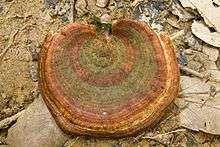Microporus
Microporus is a genus of fungi in the family Polyporaceae. The genus has a widespread distribution and, according to a 2008 estimate, contains 11 species.[3] The genus name combines the Ancient Greek words μικρός ("small") and πόρος ("pore").[4]
| Microporus | |
|---|---|
 | |
| Microporus affinis | |
| Scientific classification | |
| Kingdom: | |
| Division: | |
| Class: | |
| Order: | |
| Family: | |
| Genus: | Microporus P.Beauv. (1805) |
| Type species | |
| Microporus perula P.Beauv. (1804) | |
| Species | |
|
11 species, see text | |
| Synonyms[1] | |
Species
As of January 2017, Index Fungorum accepts 12 species in Microporus:[5]
- M. affinis (Blume & T.Nees) Kuntze (1898)
- M. affinis-microloma (Lloyd) T.Hatt. & Sotome (2013)
- M. atroalbus (Henn.) Kuntze (1898)
- M. atrovillosus Ryvarden (1975)[6]
- M. concinnus P.Beauv. (1804)
- M. incomptus (Afzel. ex Fr.) Kuntze (1898)
- M. internuntius (Corner) T. Hatt. (2005)
- M. longisporus T.Hatt. (2000)
- M. luteoceraceus D.A.Reid (1986) – Peninsular Malaysia
- M. nipponicus (Yasuda) Imazeki (1943)
- M. subvernicipes (Murrill) T.Hatt. & Sotome (2013)
- M. xanthopus (Fr.) Kuntze (1898)
Chemistry
Seven novel diterpene molecules, microporenic acids A–G, were isolated from the cultures of an undescribed species of Microporus found in the Kakamega Forest of Kenya. These compounds have antimicrobial activity against several Gram-positive bacteria, and also inhibit the formation of biofilm by Staphylococcus aureus.[7]
gollark: I don't think ubq is testing on a GTech™ computational octahedron so that might be hard.
gollark: Code to generate them totally would.
gollark: It's efficient because it keeps the CPU's vector unit very busy.
gollark: I had a very efficient implementation of SIMD-based bubble sort but it was eaten by bees.
gollark: 2^1024.
References
- "Synonymy: Microporus P. Beauv". Species Fungorum. CAB International. Retrieved 2014-09-23.
- Ryvarden, Leif (1973). "New genera in the Polyporaceae". Norwegian Journal of Botany. 30 (1): 1–5.
- Kirk, P.M.; Cannon, P.F.; Minter, D.W.; Stalpers, J.A. (2008). Dictionary of the Fungi (10th ed.). Wallingford, UK: CAB International. p. 426. ISBN 978-0-85199-826-8.
- Donk, M.A. (1960). "The generic names proposed for Polyporaceae". Persoonia. 1 (2): 173–302.
- Kirk, P.M. "Species Fungorum (version 23rd December 2016). In: Species 2000 & ITIS Catalogue of Life". Retrieved 2017-01-01.
- Ryvarden, Leif (1975). "Studies in the Aphyllophorales of Africa 3. Three new polypores from Zaïre". Bulletin du Jardin Botanique National de Belgique. 45: 197–203.
- Chepkirui, Clara; Yuyama, Kamila T.; Wanga, Lucy A.; Decock, Cony; Matasyoh, Josphat C.; Abraham, Wolf-Rainer; Stadler, Marc (2018). "Microporenic acids A–G, biofilm inhibitors, and antimicrobial agents from the basidiomycete Microporus species". Journal of Natural Products. doi:10.1021/acs.jnatprod.7b00764.
This article is issued from Wikipedia. The text is licensed under Creative Commons - Attribution - Sharealike. Additional terms may apply for the media files.